Related Research Articles

Bruce Nauman is an American artist. His practice spans a broad range of media including sculpture, photography, neon, video, drawing, printmaking, and performance. Nauman lives near Galisteo, New Mexico.
Conceptual art, also referred to as conceptualism, is art in which the concept(s) or idea(s) involved in the work take precedence over traditional aesthetic, technical, and material concerns. Some works of conceptual art, sometimes called installations, may be constructed by anyone simply by following a set of written instructions. This method was fundamental to American artist Sol LeWitt's definition of conceptual art, one of the first to appear in print:
In conceptual art the idea or concept is the most important aspect of the work. When an artist uses a conceptual form of art, it means that all of the planning and decisions are made beforehand and the execution is a perfunctory affair. The idea becomes a machine that makes the art.
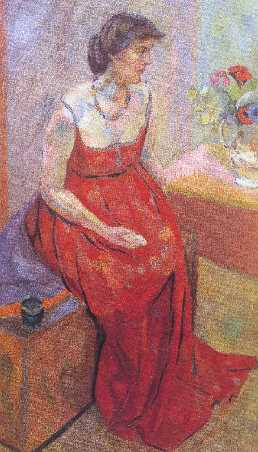
Vanessa Bell was an English painter and interior designer, a member of the Bloomsbury Group and the sister of Virginia Woolf.

Art & Language is a conceptual artists' collaboration that has undergone many changes since it was created in the late 1960s. The group was founded by artists who shared a common desire to combine intellectual ideas and concerns with the creation of art. The first issue of the group's journal, Art-Language, was published in November 1969 in England.
Graham Vivian Sutherland was a prolific English artist. Notable for his paintings of abstract landscapes and for his portraits of public figures, Sutherland also worked in other media, including printmaking, tapestry and glass design.

Stuckist demonstrations since 2000 have been a key part of the Stuckist art group's activities and have succeeded in giving them a high-profile both in Britain and abroad. Their primary agenda is the promotion of painting and opposition to conceptual art.

Lorna Simpson is an American photographer and multimedia artist. She came to prominence in the 1980s and 1990s with artworks such as Guarded Conditions and Square Deal. Simpson is most well known for her work in conceptual photography. Her works have been included in numerous exhibitions both nationally and internationally. She is best known for her photo-text installations, photo-collages, and films. Her early work raised questions about the nature of representation, identity, gender, race and history. Simpson continues to explore these themes in relation to memory and history in various media including photography, film, video, painting, drawing, audio, and sculpture.
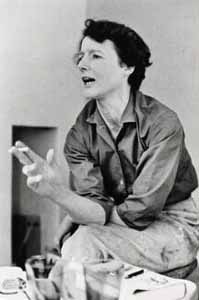
Prunella Clough was a prominent British artist. She is known mostly for her paintings, though she also made prints and created assemblages of collected objects. She was awarded the Jerwood Prize for painting, and received a retrospective exhibition at Tate Britain.
Charles Townsend Harrison, BA Hons (Cantab), MA (Cantab), PhD (London) was a UK art historian who taught Art History for many years and was Emeritus Professor of History and Theory of Art at the Open University. Although he denied being an artist himself, he was a full participant and catalyst in the Art and Language group.
Kamala Ibrahim Ishaq is a Sudanese painter and art teacher, known as one of the founders of The Crystalist conceptual art group in Khartoum. This group rejected common conventions in Sudanese modern painting of the 1960s and strived to find "an aesthetic and critical language that would emphasise the notions of pleasure and knowledge in order to permanently abolish differences and boundaries". Based on her artistic career spanning more than fifty years, Ishaq has been called one of the most important visual artists in Africa.
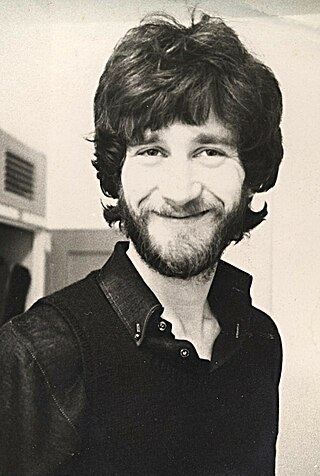
Ed Herring was a British artist who had an international career in the late 1960s and early 1970s. He is generally considered to be a conceptual artist.

The Château de Montsoreau-Museum Contemporary Art is a private museum open to the public in Montsoreau, France. It opened 8 April 2016. The permanent collection exhibited at Château de Montsoreau consists of Philippe Méaille's collection of works by the conceptual art collective Art & Language.

The British pavilion houses Great Britain's national representation during the Venice Biennale arts festivals.

Art-Language: The Journal of Conceptual Art (1969-1985) was a magazine published by the conceptual artists of Art & Language. Involving more than 20 artists in the United States, Europe, and Australia, and covering almost 20 years production, it is one of the most extensive artworks of conceptual art and is regarded as an important influence on both conceptual art and contemporary art.
I don't understand quite a good deal of what is said by Art-Language, but I admire the investigatory energies, the tireless spade-work, the full commitment to the reestablishment of a valid language by which to discuss art and the occasional humour in their writings. The chaos in their reasons fascinates me, but it is also irritating to be unequipped to evaluate their work. - Six Years: The Dematerialization of the Art Object, Lucy R. Lippard, 1973.
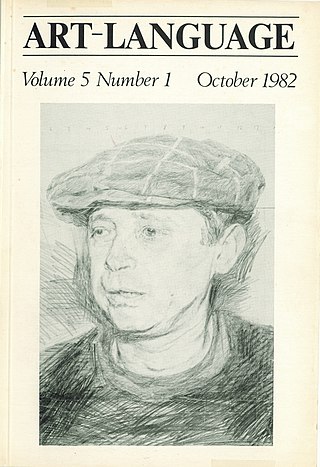
Mel Ramsden is a British conceptual artist and member of the Art & Language artist group.

Michael Baldwin is a British conceptual artist, author and founding member of the Art & Language artist group.

Harold Hurrell is a British conceptual artist and former member of the Art & Language artist group.

Secret Painting is a series of artworks created by British conceptual artist Mel Ramsden for the collective Art & Language between 1967 and 1968. The series consists of monochrome paintings juxtaposed with text panels explaining the absence of a conventional subject; for example, one states that the painting in question is invisible.
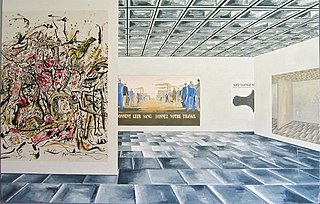
Index: Incident in a Museum is an extensive series of paintings produced between 1985 and 1988 by Michel Baldwin and Mel Ramsden, members of the British conceptual artists' collective Art & Language.

David Bainbridge was a British sculptor, Conceptual Artist and member of the artist group Art & Language.
References
- ↑ "Art & Language". Flash Art. 4 December 2015. Retrieved 18 January 2018.
- ↑ "BBC – Coventry and Warwickshire Culture – Art and Language". BBC. Retrieved 18 January 2018.
- ↑ "Largest Art & Language Collection Finds Home". artnet News. 23 June 2015. Retrieved 18 January 2018.
- ↑ Crow, Thomas (30 November 2017). "Art by the Many: London Style Cults of the 1960s". British Art Studies (7). doi: 10.17658/issn.2058-5462/issue-07/conversation . ISSN 2058-5462.
- ↑ "Lanchester Gallery Projects | Artists | Terry Atkinson". lanchestergalleryprojects.org.uk. Retrieved 18 January 2018.
- ↑ "Terry Atkinson". frieze. Retrieved 18 January 2018.
- ↑ "20 years of Turner prize-winners index". The Guardian. Retrieved 18 January 2018.
- ↑ "Search results". Tate. Retrieved 26 May 2020.